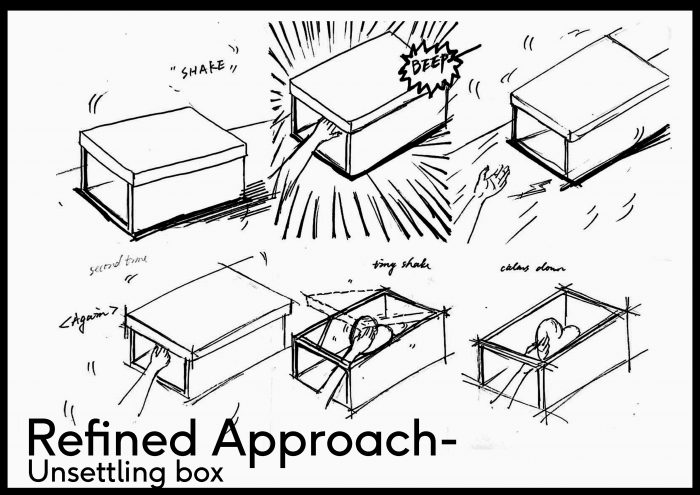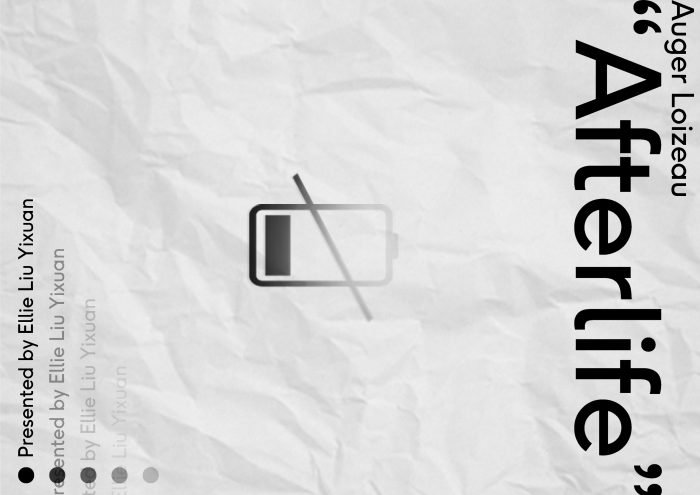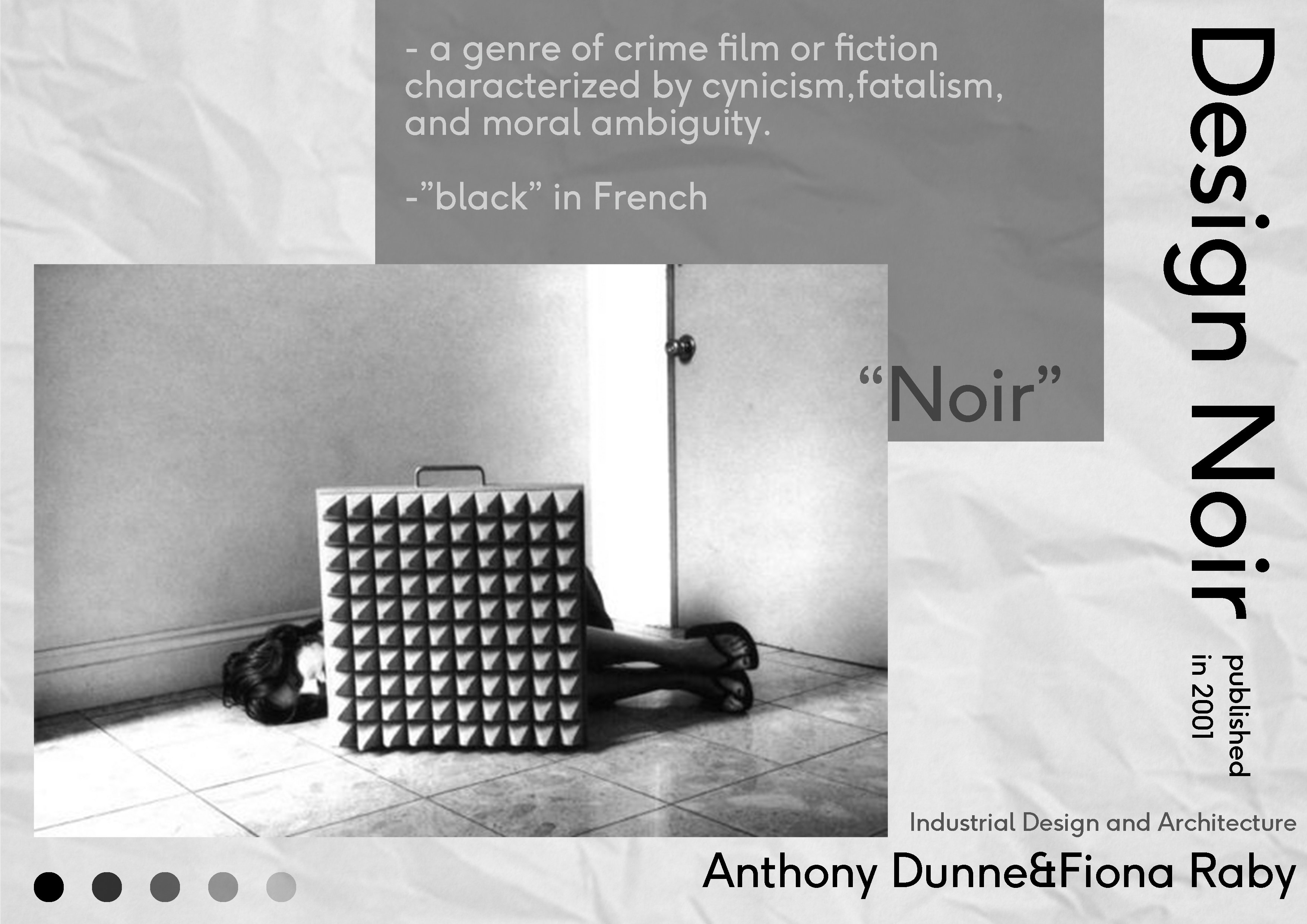
Provocative Object
Ellie&Wende

 Dunne & Raby
Dunne & Raby
Afterlife is a piece of critical design work made by Auger Loizeau, which falls under the category of Design Noir, which means it is important to know the idea of Design Noir before looking into the artwork itself.
The Design Noir is the name of the book called Design Noir: The Secret Life of Electronic Objects, written by Anthony Dunne and Fiona Raby, who are the pioneers, founders and leaders in the Critical Design Movement. This book offers the reader a clear image of the Critical Design Movement within the current context of rapid technology change, especially for electrical products. Anthony studied Industrial design in RCA and Fiona Raby studied Architecture there, too.
“Experience is more important than aesthetics”
“Concept is more important to deliverable”
“Let’s call it critical design, that questions the cultural, social and ethical implications of emerging technologies. A form of design that can help us to define the most desirable futures, and avoid the least desirable.”– Anthony Dunne & Fiona Raby
Critical design is the development of non-obvious design concepts that challenge the status quo(the current or recent state of things). This can be used to provoke new ideas for systems, products and services.
Danne and Raby state that all design is ideological and all the designs fall into two categories-affirmative and critical. Most design, especially industrial design, fall into the affirmative category, where designers design for a specific purpose to meet people’s expectation.
But nowadays, the development of parallel design activity is required to challenge industrial agendas. Because technology is developing rapidly, reflection and criticism should play an important role to explore other possibilities of the product, therefore provides a critique of the prevailing situation through designs that embody alternative social, cultural, technical or economic values.
Personally, I think Critical design is more of an attitude, the aim is to challenge people’s assumption of normal products, creating a different experience to provoke reflection and criticisms. It is to make the idea behind the design visible by creating the experience, here, the design became secondary, it is the medium of designer’s thought, the most important part of a successful critical design is the thinking and concept behind it.
But Why is critique so important in our technology era? To put it in a more understandable way, there is a quotation from the artists:
Anthony: I think as technologies become more complex and affect more people, they have the potential to create and also eliminate forms of social relations, possibilities for behaviour, and ultimately, what it means to be human. Therefore, we need to bring other disciplines into the process of developing new technologies. If only technologists and economists are in charge of the new developments, some profoundly human qualities might be in danger of being overlooked and thus written out of new technologies. Design can act as a catalyst here. We need alternative narratives – not just the motive of optimisation – driving technological development, and I think design can work with the humanities and liberal arts to develop these alternative visions. (from Virta Design Museum)
Therefore, the purpose of critical design is to
stimulate discussion and debate amongst designers industry and the public about the aesthetic quality of our electronically mediated existence(Anthony and Raby).
What are some issues with design that has to be popular?
According to Thomas Frank(2001), it is believed that the market is the only reality and the “market populism” was formed, which means that the true desire of people was expressed by the marketplace. It seemed to me that if a product cannot fit in with the market, it is pretty much worthless and unreal, which would make the Critical Design Movement more difficult as it discouraged designers from doing something new, and time by time designers will be afraid to design something that is not desirable for the market.
In my opinion, the development of technology also helped the process of global capitalization, the role of the capital is highly valued which makes both customers and sellers focus more on the profit, which is the outcome, rather than the idea and concept behind the design. Another reason might be the problem of mass production. It is undeniable that it would take more time to do the critical design installation or art, and most of them cannot be mass produced. For most critical design, they take forms of prototypes, which makes it unsuitable for the need of the market.
Additionally, if the aim of the design is just to be popular and to make profits, the function may still be there but the idea, concept and communication would be vague, which in a way promoted consumerism.
For critical design, it does not aim for mass production or making profits, which to put it in a good way, it frees designers from the rules and restrictions from the market and sets no limitation to them, so they can create anything with their imagination.
1. Designers and artists should take social responsibilities, which goes parallel with Anthony and Raby’s idea of doing non-commercial critical design to raise people’s awareness rather than simply making money.
2. In today’s context, art and science should not be considered as two separated subjects. I agree with Anthony and Rady’s understanding of the relationship between art and science. It is widely agreed that the development of human being was driven by technology, however, technology should be developed in a proper way and there are a lot of debatable scenarios about morality and humanity. For example the cloning technology. Technology can bring functional and physical improvement for human beings but its effect will only be fully expressed when collaborating with art, which takes care of the emotional and ethical aspect of life.
Additionally, the affirmative design is all about selling new products, without exploring and pushing the cultural and aesthetic potential and role of electronic products and services to its limits. This form of critical design is considered valueless and widely neglected by the public and the designers.
How the True World Finally Became a Fiction is the idea proposed by Friedrich Nietzsche that myth and storytelling are of greater influence on modern society than direct experience of reality. The idea suggests that we may doubt our senses when it conflicts with fiction.
The theory can be extended to the common business observation that the story and culture surrounding a brand can be more important than physical realities such as product durability. It can also explain the tendency for ideas in science fiction to eventually become reality.
It’s about problem-raising rather than problem-solving.
Speculating about the future. This can involve projections based on current trends or suggesting that current trends are about to suddenly end or reverse. Speculation can also involve thought experiments such as how the future will view current designs.
For example-Accelerating Change
Accelerating change is the idea that technology-driven social change is exponentially increasing. The idea stems from the observation that each decade appears to change at an increased rate. According to the theory, life changed more between 2000 and 2010 than between 1900 and 1910.
A prime example of accelerating change is the doubling of computing speed every 18 months that began in the 1960s explained by Moore’s Law. This, in turn, sparked a broad range of technological change including the commercialization of the internet and leaps forward in research in areas such as biotechnology.
It is basically implement something in a new method. According to Simplicable, developing theories and models that challenge design conventions. For example, suggesting a completely new method to captured holograms that would improve quality if it could be implemented. As a design concept, implementation details can be completely omitted such that the design may be impossible or have disadvantages that would become clear to implementers.
Critical designs may be developed as prototypes that are typically designed to challenge assumptions as opposed to a typical prototype that is intended to be a potential product. For example, an interior design that challenges conventional forms and design principles.
It is an example of critical design, it is the design for the mind and it aims to stimulate reflection. James Auger and Jimmy Loizeau were classmates in RCA, and they started to work with each other since 2001, when the Design Noir was published. They were both did MA in Design Products at RCA.
In this piece of work, they associated their design with the taboo topic- death.
There are many perspectives and beliefs on what happens to us after our lives on this planet come to an end.
When faced with our own mortality or that of a loved one, notions of what the afterlife may hold; whether it be in a spirit world such as heaven or reincarnated into another body or form, spiritual faith can offer great comfort and reassurance. This scientific research has yet to offer any tangible proof of continued existence, after death.
So in terms of comfort and reassurance what then is there for the grieving atheist?
When someone dies, their body will go back to the natural system, he may turn into wind, rain or the soil under the flower. By turning the chemical of the dead body into electricity of a battery, Afterlife offers the family a visible expression of their loved ones, creating a feeling that they are still with them and has a function, which means that they are still participating in their lives, too.
Why is it a piece of Critical Design?
Part two of afterlife seems unrelated to part one at all, but if we can go behind the look of the two work, we will find out they are questioning the same concept: the existence of human being. Do we really exist? Do we leave our spirit in the world after death? Do we fall in love with somebody because of their smell? Was the smell born with us and acting like a unique attracting characteristic of the individual or do we tend to cover our original smell with some perfume to make us more attractive? What are we and what is real? There are some questions for all of the participants to think about, and each one will come with different answers, too. But it is undeniable that it also challenges our normal assumption in life, but part two is not that technically placed in the technology context. But in a way the general background is in the tech era too.
Anthony and Raby mentioned that for critical design, the little weirdness it’s the key because it needs to challenge people’s assumption of products. But it cannot go too far, if it is too strange, people may not use it at all. If it is not strange at all, people will see the product as normal. For the first part I think that most of the people would use it but for the second one, it is way too intimate and can also be irritating, which may get fewer participants compared to the first one.
In general, to me, I think afterlife is a good piece of art and design, it successfully achieved the goal of the critical design, which is to provoke and challenge assumptions of daily life electronic objects as well as giving out an opportunity to people to think about some moral issues.

By Liu Yixuan(Ellie) and Lee Wende
Meaning of Protest, from the Cambridge Dictionary.
What is Metoo?
What does Metoo do?
(note: all the information comes from the official Metoo website https://metoomvmt.org/about/)
The aim of the Metoo movement?
To fight against sexual violence, to strive for a more equal world.
To help, to encourage, to heal the survivors and make a more inclusive community.
Note: It started with women does not mean that the movement is all about women. Men, boys, LGBT community also suffer from sexual violence. Everyone in the world has a voice to speak out loud and ask for their rights.
How did Metoo change the world?
There were more than 3 million Tweets about the #Metoo, check on the timeline published by Twitter data.
How did Metoo raise people’s awareness?
Global Impact
https://www.bbc.co.uk/search?q=metoo#page=2
Declarations by organizations and institutions
Group or mass petitions
Slogans, caricatures, and symbols
Banners, posters, and displayed communications
Skywriting and earthwriting
Mock awards
Prayer and worship
Protest disrobings
Destruction of own property
Symbolic lights
Rude gestures
Vigils
Singing
Walk-outs
Silence
Renouncing honors
Turning one’s back
Stay-at-home
Total personal noncooperation
Collective disappearance
consumers’ boycott
Withdrawal of bank deposits
Refusal to pay debts or interest
Protest strike
Working-to-rule strike
Reporting “sick” (sick-in)
Boycott of elections
Reluctant and slow compliance
Sitdown
The fast
Sit-in
Nonviolent occupation
Guerrilla theatre
Nonviolent land seizure
Politically motivated counterfeiting
Preclusive purchasing
Alternative markets
Alternative economic institutions
Overloading of administrative systems
Seeking imprisonment
Possible Approach- a figure of a mother, when it was touched, all the lights in the setting goes down, or the diagram showing the population of the world, the light goes down.
The modern world has made incredible bounds towards generating social movements to support disenfranchised groups. When thinking of social movements, people tend to conjure the image of visibly alienated groups that have become vocal in order to bring attention to and eventually change the systematic neglect they experience.

Initially, we wanted to install a really fancy kit in the drawer, which takes place in the bedroom.
The concept is that when people open the drawer, sometimes they forgot what the put inside previously, so every time is a new journey. We wanted the whole drawer lights up with LED lights, so people can see what they put inside and also creates a feeling of firework and a hidden castle underground.
But as we were doing our planning and sketches, we found that we only have only one breadboard and limited material and lights, we changed the drawer to a shoebox, which is more portable for presentation and easier for the installation of the Arduino kit.
Now the concept is that sometimes people put stuff in a container and they forgot about it, when they open it a long time later they will be surprised if there is something unexpected.
We wanted to build something cute so we decided to put an anthropomorphic figure inside instead of just a board of words, the robots will hold the board with surprise to give people a surprise.
Components
-Macbook
-Arduino
-Breadboard
-LED lights
-Photocell
-wires
-servo motor
-resistor
-cable
Two parts
Mechanics-When the lid is open, the robot will jump out and holding a board saying “surprise” and his eyes will light up(the LED).
Arduino Kit Set Up
Simulation through the web called https://www.tinkercad.com/circuits first, but sometimes it still did not work.
I also did the diagram as Lei taught us in class to make everything clearer.
Arduino Kit Installation
Details on the robot.
Inside the box.
Final product.
How does your hacked object behaves in a way you least expect it to?
When people open a box, they would expect something stable, but we changed this to a kinetic action which surprises people.
What are some reactions you observed from your participants when they interacted with the object?
Initially, participants were quite scared of opening it up because we made the box all black and changed put an arrow sign and a sticker with”What’s inside?”. The appearance of the box creates a mysterious feeling and makes people curious about what is inside, however, due to the dark colour and the setting, they were scared that something huge and scary would come out.
What are the challenges involved and how did you overcome them? What problems still exist? How might you overcome them eventually?
blue-before.
yellow-detached, after taking the needle out.
purple-after, which is the wire that we used for the LED for the project.
Demonstration of how the refined wire works with the LED leg.
4. We also got another problem which was that in the morning of the presentation, half of the wire came out of the breadboard and there were two wires that we did not totally follow the diagram, which means that we need to go through and understand the whole procedure again.
5. We took a long time discussing which is the best way to show the “creepy and cute” feeling without scaring people. We decided that we need to work on the size of the “surprise”, as long as the box was opened, the robot will come out quickly, so if people do not see it clearly but at least they know it is not a huge thing, which in a way guarantee the security feeling.
Additionally, we made the movement of the robot coming down really slow, so it calms people down and gives them time to react.
After looking at the video, the reaction is exactly what we wanted, a pleasant surprise for people, at the start when they’re looking at the black box they were worried that it will be something big and scary to scare them, but when they opened it, instead it’s a tiny awesome surprise that brought them joy, I think the anticipation before opening it up was achieved as when they’re opening up, they try to open it slowly because they’re expecting something scary. Most of the participants stated that they did not expect this kind of outcome which is what we hope to bring across. not really wanted to make them scared but something to brighten up their day.